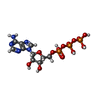+ Open data
Open data
- Basic information
Basic information
| Entry | Database: PDB / ID: 9.0E+91 | ||||||||||||
|---|---|---|---|---|---|---|---|---|---|---|---|---|---|
| Title | Ec83 Retron PtuA Dimer bound to ATP | ||||||||||||
 Components Components | Retron Ec83 probable ATPase | ||||||||||||
 Keywords Keywords | ANTIVIRAL PROTEIN / ATPase / Retron / Dimer | ||||||||||||
| Function / homology |  Function and homology information Function and homology informationDNA synthesis involved in DNA repair / double-strand break repair / defense response to virus / ATP hydrolysis activity / ATP binding Similarity search - Function | ||||||||||||
| Biological species |  | ||||||||||||
| Method | ELECTRON MICROSCOPY / single particle reconstruction / cryo EM / Resolution: 3.31 Å | ||||||||||||
 Authors Authors | Rish, A.D. / Wang, C. / Fu, T.M. | ||||||||||||
| Funding support |  United States, 3items United States, 3items
| ||||||||||||
 Citation Citation |  Journal: Science / Year: 2025 Journal: Science / Year: 2025Title: Disassembly activates Retron-Septu for antiphage defense. Authors: Chen Wang / Anthony D Rish / Emily G Armbruster / Jiale Xie / Anna B Loveland / Zhangfei Shen / Bradley Gu / Andrei A Korostelev / Joe Pogliano / Tian-Min Fu /  Abstract: Retrons are antiphage defense systems that produce multicopy single-stranded DNA (msDNA) and hold promise for genome engineering. However, the mechanisms of defense remain unclear. The Retron-Septu ...Retrons are antiphage defense systems that produce multicopy single-stranded DNA (msDNA) and hold promise for genome engineering. However, the mechanisms of defense remain unclear. The Retron-Septu system integrates retron and Septu antiphage defenses. Cryo-electron microscopy structures reveal asymmetric nucleoprotein complexes comprising a reverse transcriptase, msDNA (a hybrid of msdDNA and msrRNA), and two PtuAB copies. msdDNA and msrRNA are essential for assembling this complex, with msrRNA adopting a conserved lariat-like structure that regulates reverse transcription. Notably, the assembled Retron-Septu complex is inactive, with msdDNA occupying the PtuA DNA binding site. Activation occurs upon disassembly, releasing PtuAB, which degrades single-stranded DNA to restrict phage replication. This "arrest-and-release" mechanism underscores the dynamic regulatory roles of msDNA, advancing our understanding of antiphage defense strategies. | ||||||||||||
| History |
|
- Structure visualization
Structure visualization
| Structure viewer | Molecule:  Molmil Molmil Jmol/JSmol Jmol/JSmol |
|---|
- Downloads & links
Downloads & links
- Download
Download
| PDBx/mmCIF format |  9e91.cif.gz 9e91.cif.gz | 167.9 KB | Display |  PDBx/mmCIF format PDBx/mmCIF format |
|---|---|---|---|---|
| PDB format |  pdb9e91.ent.gz pdb9e91.ent.gz | 129.3 KB | Display |  PDB format PDB format |
| PDBx/mmJSON format |  9e91.json.gz 9e91.json.gz | Tree view |  PDBx/mmJSON format PDBx/mmJSON format | |
| Others |  Other downloads Other downloads |
-Validation report
| Summary document |  9e91_validation.pdf.gz 9e91_validation.pdf.gz | 1.1 MB | Display |  wwPDB validaton report wwPDB validaton report |
|---|---|---|---|---|
| Full document |  9e91_full_validation.pdf.gz 9e91_full_validation.pdf.gz | 1.1 MB | Display | |
| Data in XML |  9e91_validation.xml.gz 9e91_validation.xml.gz | 38.8 KB | Display | |
| Data in CIF |  9e91_validation.cif.gz 9e91_validation.cif.gz | 56.5 KB | Display | |
| Arichive directory |  https://data.pdbj.org/pub/pdb/validation_reports/e9/9e91 https://data.pdbj.org/pub/pdb/validation_reports/e9/9e91 ftp://data.pdbj.org/pub/pdb/validation_reports/e9/9e91 ftp://data.pdbj.org/pub/pdb/validation_reports/e9/9e91 | HTTPS FTP |
-Related structure data
| Related structure data |  47739MC  9e8zC  9e90C  9o4aC M: map data used to model this data C: citing same article ( |
|---|---|
| Similar structure data | Similarity search - Function & homology  F&H Search F&H Search |
- Links
Links
- Assembly
Assembly
| Deposited unit | 
|
|---|---|
| 1 |
|
- Components
Components
| #1: Protein | Mass: 61767.902 Da / Num. of mol.: 2 Source method: isolated from a genetically manipulated source Source: (gene. exp.)   #2: Chemical | Has ligand of interest | Y | Has protein modification | N | |
|---|
-Experimental details
-Experiment
| Experiment | Method: ELECTRON MICROSCOPY |
|---|---|
| EM experiment | Aggregation state: PARTICLE / 3D reconstruction method: single particle reconstruction |
- Sample preparation
Sample preparation
| Component | Name: Complete Ec83 retron complex / Type: COMPLEX / Entity ID: #1 / Source: RECOMBINANT |
|---|---|
| Molecular weight | Experimental value: NO |
| Source (natural) | Organism:  |
| Source (recombinant) | Organism:  |
| Buffer solution | pH: 7.5 |
| Specimen | Embedding applied: NO / Shadowing applied: NO / Staining applied: NO / Vitrification applied: YES |
| Vitrification | Cryogen name: ETHANE |
- Electron microscopy imaging
Electron microscopy imaging
| Experimental equipment |  Model: Titan Krios / Image courtesy: FEI Company |
|---|---|
| Microscopy | Model: TFS KRIOS |
| Electron gun | Electron source:  FIELD EMISSION GUN / Accelerating voltage: 300 kV / Illumination mode: FLOOD BEAM FIELD EMISSION GUN / Accelerating voltage: 300 kV / Illumination mode: FLOOD BEAM |
| Electron lens | Mode: BRIGHT FIELD / Nominal defocus max: 2000 nm / Nominal defocus min: 500 nm |
| Image recording | Electron dose: 50 e/Å2 / Film or detector model: GATAN K3 BIOQUANTUM (6k x 4k) |
- Processing
Processing
| EM software | Name: PHENIX / Category: model refinement | ||||||||||||||||||||||||
|---|---|---|---|---|---|---|---|---|---|---|---|---|---|---|---|---|---|---|---|---|---|---|---|---|---|
| CTF correction | Type: NONE | ||||||||||||||||||||||||
| 3D reconstruction | Resolution: 3.31 Å / Resolution method: FSC 0.143 CUT-OFF / Num. of particles: 684906 / Symmetry type: POINT | ||||||||||||||||||||||||
| Refinement | Highest resolution: 3.31 Å Stereochemistry target values: REAL-SPACE (WEIGHTED MAP SUM AT ATOM CENTERS) | ||||||||||||||||||||||||
| Refine LS restraints |
|
 Movie
Movie Controller
Controller







 PDBj
PDBj

